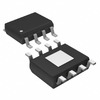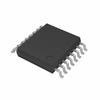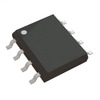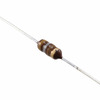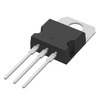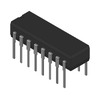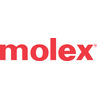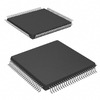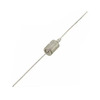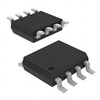74HC595D Shift Register Breakdown: Pinout, Datasheet, and System Diagram Explained
The 74HC595D is a high-performance 8-bit shift register/latch, widely recognized for its role in efficient serial-to-parallel data conversion. Leveraging advanced silicon gate C2MOS technology, it offers low power consumption, high noise immunity, and reliable operation, making it a popular choice for modern electronics. Its ability to reduce the number of microcontroller pins needed for interfacing is especially beneficial in space-constrained designs, allowing you to optimize layouts and performance with ease. This article digs into the 74HC595D’s technical details, applications, and benefits, providing insights into its practical use and efficiency in circuit design.Catalog
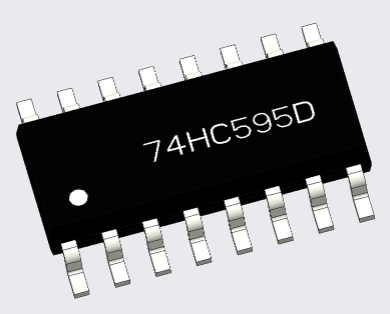
74HC595D Detailed Exploration
The 74HC595D is an 8-bit shift register/latch that is meticulously planned using advanced silicon gate C2MOS technology. This sophisticated design ensures it operates at speeds akin to LSTTL circuits, combining power efficiency typical of CMOS technology. Its core components include an 8-bit static shift register and an 8-bit storage register. When the SCK input undergoes a positive transition, data smoothly shifts through the register. Furthermore, upon a positive transition at the RCK input, this data seamlessly transfers to the storage register.
A noteworthy feature of the 74HC595D is the division of the RCK and SCK signals, which significantly stabilizes and maintains parallel outputs throughout the shifting process. This is especially beneficial in contexts needing minimal data corruption and high output integrity. The device features 3-state parallel outputs that enable easy connections to an 8-bit bus, enhancing its utility in various serial-to-parallel conversion tasks.
You can often turn to the 74HC595D for a myriad of practical applications, mostly in serial-to-parallel conversion and data reception. The design incorporates protective mechanisms against static discharge and transient voltage spikes. This assures dependable performance across different environments. In circuit design and implementation, the 74HC595D is praised for its efficiency and robustness, qualities that are sought after for reducing power consumption while maintaining high-speed data processing capabilities. This aspect is increasingly relevant in modern electronics where both energy savings and performance are highly valued.
74HC595D Pin Configuration

74HC595D CAD Representations
Symbol
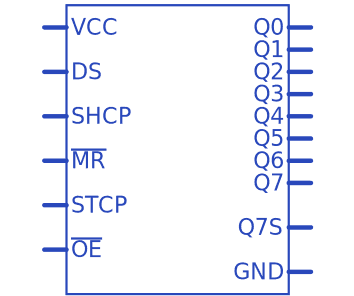
Footprint

3D Model
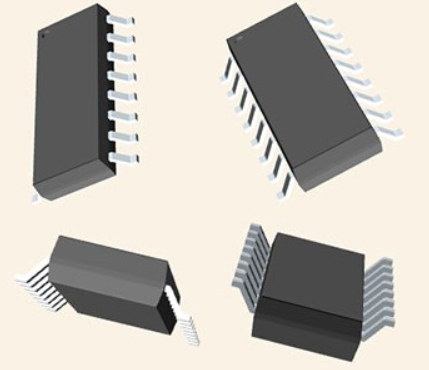
Features of 74HC595D
|
Feature |
Description |
|
High speed |
fMAX = 55 MHz (typ.) at VCC = 5 V |
|
Low power dissipation |
ICC = 4.0 µA (max) at Ta = 25°C |
|
Balanced propagation delays |
tPLH ≈ tPHL |
|
Wide operating voltage range |
VCC(opr) = 2.0 V to 6.0 V |
Technical Specifications
|
Type |
Parameter |
|
Factory Lead Time |
12 Weeks |
|
Mounting Type |
Surface Mount |
|
Package / Case |
16-SOIC (0.154, 3.90mm Width) |
|
Number of Elements |
1 |
|
Operating Temperature |
-40°C ~ 125°C |
|
Packaging |
Cut Tape (CT) |
|
Series |
74HC |
|
Part Status |
Active |
|
Moisture Sensitivity Level (MSL) |
1 (Unlimited) |
|
Voltage - Supply |
2V ~ 6V |
|
Function |
Serial to Parallel |
|
Output Type |
Tri-State |
|
Logic Type |
Shift Register |
|
Number of Bits per Element |
8 |
|
RoHS Status |
RoHS Compliant |
IEC Logic Representation of 74HC595D

System Diagram of 74HC595D

Alternatives of 74HC595D
|
Part |
Compare |
Manufacturers |
Category |
Description |
|
74HC595D |
Current Part |
NXP |
Shift Registers |
NXP 74HC595D Shift Register, HC Family, 74HC595, Serial
to Parallel, Serial to Serial, 1Element, 8Bit, SOIC |
|
74HC595D,118 |
74HC595D VS 74HC595D,118 |
NXP |
Shift Registers |
NXP 74HC595D,118 Shift Register, HC Family, 74HC595,
Serial to Parallel, Serial to Serial, 8Element, 8Bit, SOIC |
|
74HC595D-Q100,118 |
74HC595D VS 74HC595D-Q100,118 |
NXP |
Shift Registers |
IC SHIFT REGISTER 8Bit 16SOIC |
|
SN74HC595N |
74HC595D VS SN74HC595N |
TI |
Shift Registers |
Shift Register, HC Family, 74HC595, Serial to Parallel,
1Element, 8Bit, DIP, 16Pins |
Optimal Scenarios for 74HC595D Utilization
The 74HC595D is ideally suited for controlling LED boards, especially when tasked with managing a large number of LEDs using a microcontroller. This shift register streamlines the process of multiplexing, thus significantly reducing the I/O pin count required on the microcontroller. For instance, in complex display systems like scoreboards or dynamic informational boards, integrating the 74HC595D can simplify the overall circuit design, making it more efficient and manageable.
Interface with LCD Screens
The 74HC595D efficiently interfaces with LCD screens by supplying the basic data bits, establishing a seamless communication channel between the microcontroller and the display. This feature allows smoother updates of the display content. It is mostly advantageous in control panels of industrial machines and consumer electronics, where clear and timely information display is active. This integration encourages more compact and cost-effective designs.
Controlling 5V Loads with 3.3V Microcontrollers
The 74HC595D is capable of controlling 5V loads, such as relays, through a 3.3V microcontroller, owing to its 3.15V high-level voltage capability. This attribute is mainly useful in environments that require reliable switching mechanisms within constrained power systems. Practical applications include home automation systems and robotics, where managing higher voltage components from a lower voltage logic circuit is useful for smooth and efficient operations. Incorporating the 74HC595D ensures smoother transitions between different voltage domains, thereby maintaining the integrity of the entire system.
Enhancing Reliability and Scalability
One notable strength of the 74HC595D is its role in boosting the reliability and scalability of electronic circuits. Experience shows that shift registers like the 74HC595D help maintain signal integrity over longer distances, a common requirement in large-scale LED installations like architectural lighting systems or extensive public information displays. They also simplify the design architecture, making it easier to expand the number of controllable outputs with minimal hardware changes, thus ensuring the system remains adaptable to future needs.
Design Efficiency and Power Management
Integrating the 74HC595D into circuit designs enhances overall design efficiency and power management. Its ability to centralize control facilitates organized power distribution, which is crucial in battery-powered devices where energy conservation is a priority. This benefit aligns with contemporary design philosophies that emphasize minimal power consumption while maximizing performance, as seen in wearable technology and portable medical devices.
Common Applications of 74HC595D
Serial-to-Parallel Data Conversion
The 74HC595D is frequently employed in scenarios where data needs to transition from a serial format to a parallel format. This capability is serious in various digital applications that demand efficient data management and processing. Microcontroller-based systems often face the challenge of limited GPIO pins. By leveraging the 74HC595D, these systems can effectively control a greater number of outputs with fewer input pins, optimizing the available resources.
In practical applications, you can frequently use this IC to drive LED matrices or manage multiple devices, such as relays or display segments. Sending data serially and then expanding it into parallel outputs simplifies wiring and reduces the pin count needed for complex operations. The use of the 74HC595D has been shown through experience to streamline hardware design, resulting in more compact and efficient circuit boards.
Remote Control Holding Registers
Another outstanding application of the 74HC595D is its role in remote control holding registers, which is mostly beneficial in programmable logic controllers (PLCs) and other industrial automation systems. This device can store control signals, even when they are not actively being transmitted. You can often discover that using the 74HC595D with remote control systems enhances reliability and diminishes the frequency of manual interventions. Moreover, the holding registers function as intermediate buffers, improving data integrity over long-distance communications. Reducing the need for continuous data transmission indirectly leads to lower power consumption and boosts overall system efficiency.
74HC595D Physical Dimensions
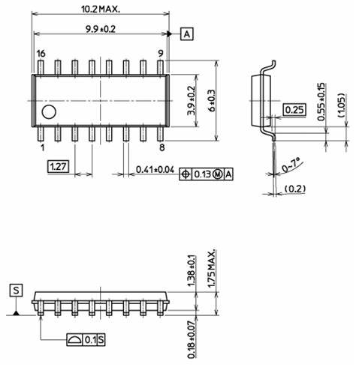
Manufacturer Information
Toshiba Semiconductor & Storage presents a diverse array of technology solutions that energize Original Equipment Manufacturers (OEMs), Original Design Manufacturers (ODMs), Contract Manufacturers (CMs), and fabless chip companies. These solutions promote the development of sophisticated integrated products across multiple markets, including computing, networking, communications, digital consumer electronics, and automotive applications.
Toshiba's mastery of semiconductor and storage technology is evident in its various contributions. In computing, their microprocessors and memory solutions meet the burgeoning need for more potent and efficient computing capabilities. In networking and communications, Toshiba's components ensure dependable and high-speed data transfer, used for modern infrastructure's dangerous applications. The digital consumer market flourishes with Toshiba's innovations, enhancing your experiences through superior device performance and energy efficiency. Within the automotive industry, Toshiba's semiconductors drive the transition towards more intelligent and energy-efficient vehicles. Their technologies pave the way for advancements in electric vehicles (EVs), autonomous driving systems, and in-car entertainment. Practical experiences demonstrate that employing Toshiba's optimized power management ICs and sensors significantly extends EV range and reliability, making them more appealing to consumers and manufacturers.
Toshiba's impact is especially profound in networking and communications. Their high-speed and low-latency components are useful for creating next-gen networks, mostly in the drive towards 5G technology. They also supply used components that ensure seamless connectivity and high data throughput. Industry feedback emphasizes that integrating Toshiba's solutions markedly improves network efficiency and reliability, supporting diverse applications from enhanced mobile broadband to Internet of Things (IoT) devices.
Datasheet PDF
74HC595D Datasheets:
Cylindrical Battery Holders.pdf
SN74HC595N Datasheets:
Frequently Asked Questions [FAQ]
1. What is the 74HC595D?
The 74HC595D is an integrated circuit that combines an 8-stage serial shift register with a storage register and tri-state outputs. It employs separate clocks for the shift and storage registers, with data transitioning on the positive edge of the shift register clock input (SHCP). Display of the data from the storage register occurs when the output enable input (OE) is LOW.
2. How does the 74HC595D function?
The 74HC595D operates using a Serial-In Parallel-Out (SIPO) protocol. The microcontroller sends data serially to the shift register, subsequently outputted through parallel pins. Each chip provides eight additional output pins, allowing for expanded I/O capabilities when used together. Multiple 74HC595D chips can connect in a daisy-chain configuration, significantly increasing potential output pins. This adaptability is mainly beneficial in projects requiring numerous output signals, such as driving multiple LEDs or managing complex digital displays. Understanding the synchronization between serial data input and clock signals is suitable for reliable performance. In many embedded systems, precise timing ensures data integrity during shifts.
3. What distinguishes the 74HC595 from the 74HC595D?
The primary distinction lies in branding and packaging specifics. The 74HC595D's 'D' suffix indicates a specific packaging (Small Outline Integrated Circuit - SOIC) or operating temperature range, suited for particular manufacturing or environmental conditions. While 74HC595 serves as the generic name, manufacturers such as Texas Instruments denote their version with the 'SN' prefix. Selecting the appropriate packaging, such as the 74HC595D, can improve system performance and longevity, especially considering design constraints like space or operating environment. This decision often leverages yourl experience, balancing technical specifications with practical build scenarios for the most effective outcomes.
About us
ALLELCO LIMITED
Read more
Quick inquiry
Please send an inquiry, we will respond immediately.
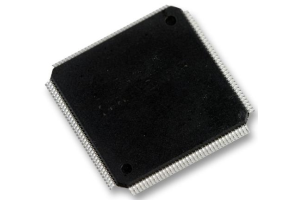
Mastering the STM32F767ZIT6: Pinout, Applications, and Datasheet Details
on October 17th

Understanding the LM2907 Key Features and Uses
on October 17th
Popular Posts
-

What is GND in the circuit?
on January 1th 3272
-

RJ-45 Connector Guide: RJ-45 Connector Color Codes, Wiring Schemes, R-J45 Applications, RJ-45 Datasheets
on January 1th 2815
-

Understanding Power Supply Voltages in Electronics VCC, VDD, VEE, VSS, and GND
on November 20th 2642
-

Fiber Connector Types: SC Vs LC And LC Vs MTP
on January 1th 2265
-

Comparison Between DB9 and RS232
on January 1th 1882
-

What Is An LR44 Battery?
Electricity, that ubiquitous force, quietly permeates every aspect of our daily lives, from trivial gadgets to life-threatening medical equipment, it plays a silent role. However, truly grasping this energy, especially how to store and efficiently output it, is no easy task. It is against this background that this article will focus on a type of coin cell battery that may seem insignificant on the...on January 1th 1846
-

Understanding the Fundamentals:Inductance Resistance, andCapacitance
In the intricate dance of electrical engineering, a trio of fundamental elements takes center stage: inductance, resistance, and capacitance. Each bears unique traits that dictate the dynamic rhythms of electronic circuits. Here, we embark on a journey to decipher the complexities of these components, to uncover their distinct roles and practical uses within the vast electrical orchestra. Inductan...on January 1th 1808
-

What Is RF and Why Do We Use It?
Radio Frequency (RF) technology is a key part of modern wireless communication, enabling data transmission over long distances without physical connections. This article delves into the basics of RF, explaining how electromagnetic radiation (EMR) makes RF communication possible. We will explore the principles of EMR, the creation and control of RF signals, and their wide-ranging uses. The article ...on January 1th 1801
-

CR2430 Battery Comprehensive Guide: Specifications, Applications and Comparison to CR2032 Batteries
What is CR2430 battery ?Benefits of CR2430 BatteriesNormCR2430 Battery ApplicationsCR2430 EquivalentCR2430 VS CR2032Battery CR2430 SizeWhat to look for when buying the CR2430 and equivalentsData Sheet PDFFrequently Asked Questions Batteries are the heart of small electronic devices. Among the many types available, coin cells play a crucial role, commonly found in calculators, remote controls, and ...on January 1th 1799
-

Comprehensive guide to hFE in transistors
Transistors are crucial components in modern electronic devices, enabling signal amplification and control. This article delves into the knowledge surrounding hFE, including how to select a transistor's hFE value, how to find hFE, and the gain of different types of transistors. Through our exploration of hFE, we gain a deeper understanding of how transistors work and their role in electronic circu...on November 20th 1782

